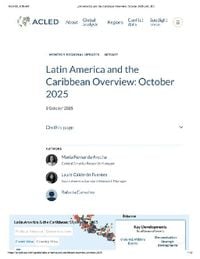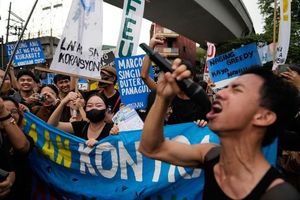It’s been a tumultuous autumn across Latin America, with political drama, street protests, and international intrigue playing out from Buenos Aires to Caracas. In Argentina, President Javier Milei, who swept into office in December 2023 with a flair for the dramatic and a chainsaw in hand, now finds himself on the ropes as the country’s mid-term elections approach. The stakes could hardly be higher, both for Milei and for a region long marked by cycles of hope and disappointment.
On September 7, 2025, the political winds shifted decisively against Milei when his party suffered a crushing defeat in the Buenos Aires provincial elections. According to ACLED, the left-leaning Peronist opposition captured 47% of the vote, capitalizing on growing discontent over Milei’s economic policies and a burgeoning corruption scandal involving his sister and chief adviser, Karina Milei. The defeat was more than symbolic—it rattled financial markets, forcing the Central Bank to burn through over $1 billion in reserves to prop up the battered peso.
With Argentina facing $20 billion in foreign debt repayments next year and the treasury running on fumes, Milei turned to Washington for a lifeline. US Treasury Secretary Scott Bessent responded with a $20 billion swap line, aimed at shoring up Argentina’s liquidity. But the move came with strings attached. Sitting alongside Milei at the White House on October 14, President Donald Trump delivered a message that many in Argentina found chilling: “You know, our approvals are somewhat subject to who wins the election. If [Milei] loses, we are not going to be generous with Argentina.” It was a statement that, as Gwynne Dyer wrote, sounded more like a mafia threat than diplomatic support.
As if the economic crisis and international pressure weren’t enough, Milei’s government has faced a surge of popular resistance at home. In September, more than 60 peaceful protests erupted across 20 provinces, targeting Milei’s vetoes of the Pediatric Emergency, Disability Emergency, and University Funding laws. These demonstrations, tracked by ACLED, represented a 40% jump over the previous month and signaled a groundswell of frustration with the president’s austerity measures. In a striking rebuke, Argentina’s national congress overturned Milei’s veto on the Disability Emergency Law—the first such reversal since he took office.
Corruption allegations have only added fuel to the fire. The leaked audio of a former government official accusing Karina Milei of accepting bribes related to the purchase of medicines for people with disabilities has further eroded public trust. As the October 26 legislative elections draw near, many analysts believe US support may not be enough to prevent another electoral disaster for Milei, raising questions about the stability of his government and the future direction of Argentina’s battered democracy.
Argentina’s struggles are emblematic of deeper, region-wide challenges. Latin America, with its 600 million people, abundant natural resources, and shared cultural heritage, has long puzzled observers with its persistent economic and political troubles. As Dyer notes, “By population, Latin America is more than one-third of the ‘West’. The languages it speaks are all derived from Latin and in most cases are almost mutually comprehensible.” Yet, despite these advantages, the region’s per capita income remains less than half that of Europe, and its governments are often weak and beset by crises.
Other countries in the region are grappling with their own storms. In Brazil, the political landscape was rocked on September 11, 2025, when former President Jair Bolsonaro was sentenced to 27 years in prison for orchestrating the failed coup attempt of January 8, 2023. The verdict, which also saw seven of Bolsonaro’s inner circle receive lengthy sentences, triggered a wave of demonstrations—both for and against the ex-president. According to ACLED, protests related to Bolsonaro’s trial and subsequent political maneuvering in Congress jumped by about a third from the previous month. While Bolsonaro’s supporters pushed for amnesty and legal protections, left-leaning parties mobilized across all 27 state capitals to oppose any leniency and to defend Brazilian sovereignty against what they saw as US interference, particularly Trump’s threats of tariffs and sanctions.
Meanwhile, in Venezuela, tensions with the United States have escalated sharply. Between September 2 and 19, US forces carried out at least three drone strikes off the Venezuelan coast, killing 17 people. Washington has justified these actions as part of its fight against drug trafficking, with President Trump accusing the Maduro government of enabling criminal networks. But critics, including the United Nations and human rights experts, have condemned the strikes as extrajudicial killings and warned that such tactics could spread to other countries. Venezuelan President Nicolás Maduro denounced the attacks as attempts at regime change or resource grabs, mobilizing troops and militias in response and warning neighboring countries against supporting US operations. US Secretary of State Marco Rubio signaled that more strikes could be on the horizon, raising fears of further escalation.
Elsewhere, unrest continues to roil Ecuador and Haiti. In Ecuador, President Daniel Noboa’s decision to scrap a fuel subsidy on September 12 sparked widespread protests, led by the National Confederation of Indigenous Nationalities of Ecuador (CONAIE), farmers, and transporters. The government’s hardline response—including curfews, a state of emergency, and the arrest of around 100 demonstrators—has only hardened opposition. The violence reached a tragic peak on September 28, when an Indigenous man was killed during clashes with security forces, prompting calls from CONAIE for continued resistance.
Haiti, too, remains mired in violence and uncertainty. The Viv Ansanm alliance, a powerful gang coalition, expanded its operations in September, launching deadly attacks in several departments and contributing to a 50% spike in fatalities compared to the previous month. On September 11, at least 50 people were killed in Labodrie, Ouest department, in retaliation for the slaying of a gang leader. Drone strikes in gang-controlled areas of the capital, conducted by a government task force with private security support, have killed around 30 people, including children. The lack of transparency around these operations has drawn sharp criticism from local human rights groups. Amid this chaos, the UN Security Council approved a US-backed plan on September 30 to create a new 5,500-officer suppression force to replace the beleaguered Kenya-led mission—though its success remains far from certain.
Across the region, the cycle of crisis and response continues. From Argentina’s economic woes and political infighting, to Brazil’s deepening polarization, to Venezuela’s confrontation with the US, Latin America faces a future as uncertain as ever. The questions of why the region struggles to match the prosperity of Europe or North America, and how it might break free from its historical patterns, remain as urgent—and as elusive—as ever.





